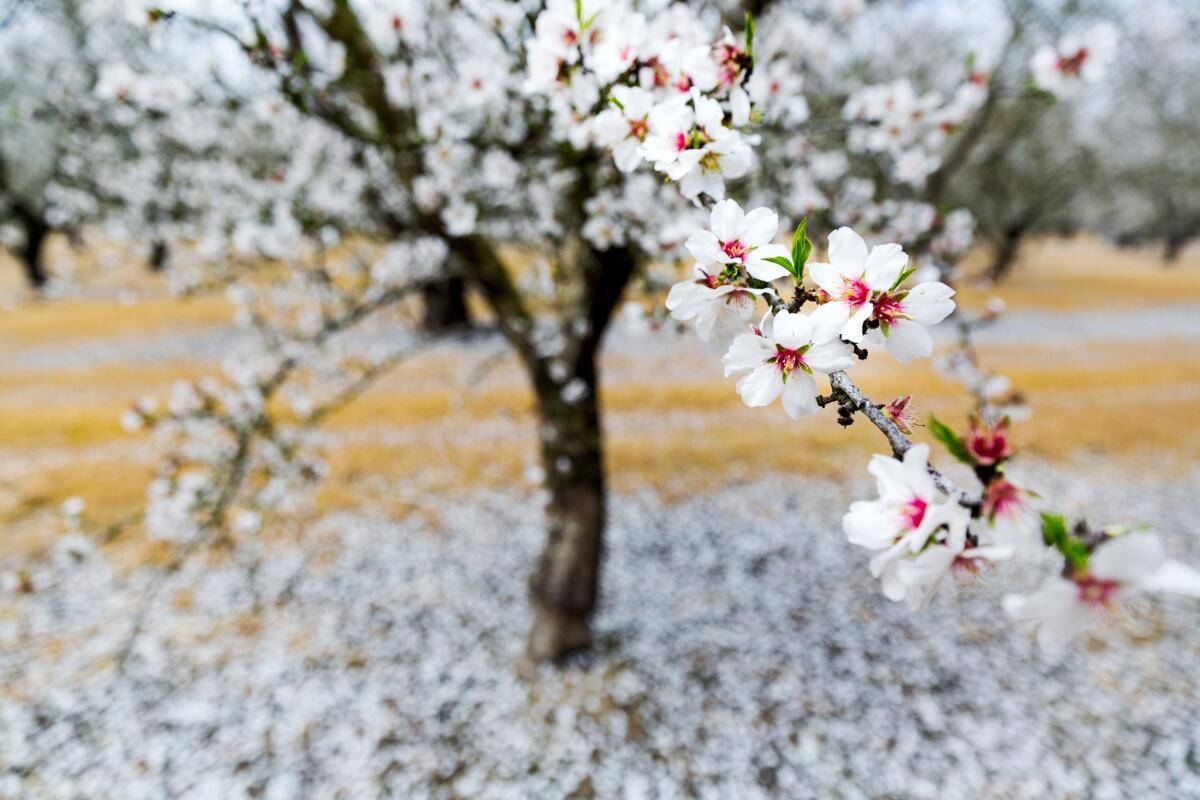Trump’s EPA undoes effort to ban pesticide linked to nervous system damage in kids

The move is a reversal of a 2015 ban imposed by the Obama-era EPA. (Sign up for our free video newsletter here http://bit.ly/2n6VKPR)
- Share via
The U.S. Environmental Protection Agency on Wednesday reversed an Obama administration recommendation to ban a pesticide linked to nervous system damage in children.
Newly installed EPA administrator Scott Pruitt signed an order that would allow farmers to continue using chlorpyrifos, which is sprayed on more than a dozen crops, including tree nuts, soybeans, corn, wheat, apples and citrus.
The Obama administration had announced in 2015 that the agency would adopt a “zero tolerance” policy for residue of the chemical on food, a move that effectively would have ended its use.
“By reversing the previous administration’s steps to ban one of the most widely used pesticides in the world, we are returning to using sound science in decision-making — rather than predetermined results,” Pruitt said of the decision.
Pruitt’s action came in response to complaints by the agricultural and chemical industries that the Obama administration had cut short a review of the scientific evidence about the chemical’s effects on humans. The administration was under pressure from an order by the U.S. 9th Circuit Court of Appeals to speed up its ruling on the safety of the chemical.

The court order sprang from lawsuits by the Pesticide Action Network and Natural Resources Defense Council, which had petitioned the EPA in 2007 to ban the chemical. Pruitt denied that petition Wednesday.
Kristin Schafer, policy director at Pesticide Action Network, accused EPA of caving to corporate pressure.
“The new administration’s agency ignored their own findings that all exposures to chlorpyrifos on foods, in drinking water, and from pesticide drift into schools, homes and playgrounds are unsafe,” Schafer said.
The Natural Resources Defense Council said Thursday it would fight Pruitt’s action in court.
“If the EPA refuses to protect the American people from this hazardous pesticide, we’ll take them to court. The health of our children depends on it,” said Miriam Rotkin-Ellman, a senior scientist at NRDC.
The U.S. Department of Agriculture praised Pruitt’s action.
“This frees American farmers from significant trade disruptions that could have been caused by an unnecessary, unilateral revocation of chlorpyrifos tolerances in the United States,” said Sheryl Kunickis, director of the USDA’s Office of Pest Management Policy. “It is also great news for consumers, who will continue to have access to a full range of both domestic and imported fruits and vegetables.”
About 5 million to 10 million pounds of chlorpyrifos, the bulk of it manufactured by Dow AgroSciences, are used annually on crops nationwide. The chemical is an organophosphate, a class of chemicals originally designed as a nerve agent weapon.
Chlorpyrifos has been banned from consumer products and residential use nationwide for more than 15 years. Several studies have suggested it can impair cognitive development in children. A UC Berkeley study found that 7-year-old children in the Salinas Valley who were exposed to high levels during pregnancy had slightly lower IQ scores than their peers. A Columbia University study showed similar effects at lower exposure.
In 2006, the EPA revised its tolerance levels for the chemical and limited the crops on which it can be applied.
In California, the Department of Pesticide Regulation restricted use of chlorpyrifos in 2015, requiring licensing, training and oversight by county agriculture commissions. It also tightened buffer zone requirements around fields where the chemical was applied, and banned its use near schools and other facilities when winds exceed 10 miles per hour.
Use of the chemical in California declined from a peak of more than 2 million pounds in 2005 to about 1.1 million in 2012, but rose to nearly 1.5 million pounds in 2013, the last year for which complete data were available, according to the state Department of Pesticide Regulation.
Environmental activists attribute the increase to the rise in almond production, which has been increasing rapidly in counties where the chemical is most heavily applied, according to the National Agricultural Statistics Service.
More than 500,000 pounds of the chemical were applied to crops in Kern and Fresno counties in 2013, by far the biggest users of the pesticide, according to the state Department of Pesticide Regulation.
Follow me: @LATgeoffmohan
ALSO
Farmworker union underpaid its own organizers, judge rules
Wages rise on California farms. Americans still don’t want the job
Water rule rollback gives growers what they wanted from Trump
UPDATES:
2:07 p.m.: This article was updated with comments from the Natural Resources Defense Council.
This article was originally published at 4 a.m.
More to Read
Inside the business of entertainment
The Wide Shot brings you news, analysis and insights on everything from streaming wars to production — and what it all means for the future.
You may occasionally receive promotional content from the Los Angeles Times.











